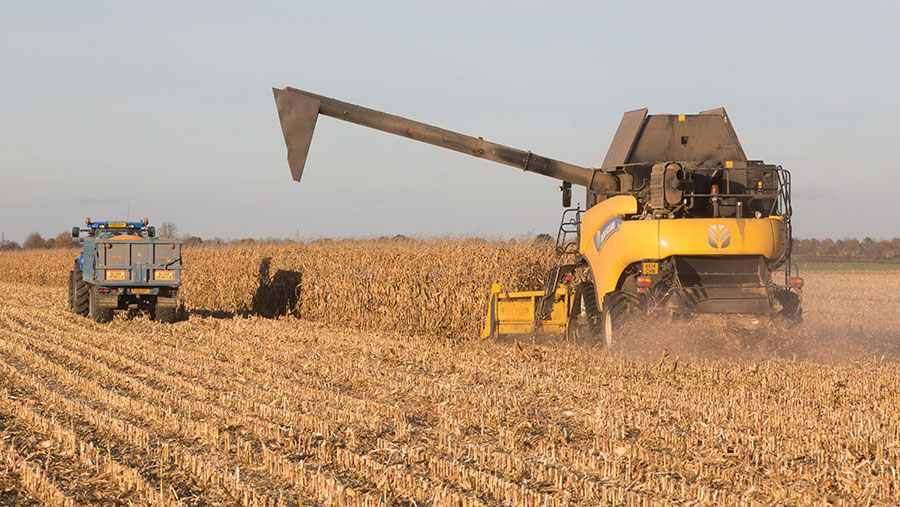How a farmer cut purchased feed costs by growing grain maize
 © Tim Scrivener
© Tim Scrivener Austin Russell has reduced purchased feed costs by £37,050 annually since including corn cob maize in the herd’s ration.
About 73ha (180 acres) of maize is grown annually at Church Farm, Barnsley, as feed for his high-yielding herd of 240 Holsteins.
Until 2019, the entire crop had been harvested as forage maize, but exceptional levels of rainfall that autumn prevented harvesting when the plant was still green.
Mr Russell decided to combine the crop instead when the weather improved, and conditions were dry enough.
See also: How growing maize with beans can improve silage quality
But there were grain losses out of the back of the combine and the grain was expensive to dry.
“A lot of the husky pith came in with the grain because we were growing forage maize varieties, and that had a very high moisture content,’’ says Mr Russell.
Farm facts
- 240 Holsteins
- Produces 12,000 litres a cow a year
- 360ha (889 acres) farmed
- 202ha (500 acres) of combinable crops
- Milk supplied to M&S
Changing tack
However, when it was included in the ration, milk yield increased, so Mr Russell decided to grow specific grain maize varieties and use a different harvesting technique.
A forager, fitted with a corn cracker, chopped the cob, processed the grain and applied a preservative to minimise aerobic spoilage in the clamp.
This made a product very high in starch with some of the characteristics of silage.

Austin Russell © Eloise Russell
“Although it is a high-starch product, it is not mega-concentrated. It feeds really well and the cows love it,’’ says Mr Russell.
“We are effectively producing a high-energy concentrate for £90/t.’’
The 2020 crop yielded 450t freshweight from 32ha (80 acres) and analysed at 49% starch, 50% dry matter (DM) and 11% metabolisable energy (ME), compared with his forage maize at 30% starch, 30% DM and 12% ME.
The high yield was the reason acreage has now been halved.
This spring, 16ha (40 acres) of grain maize was drilled and, although forage maize still accounts for the bulk of maize production at 45ha (115 acres), Mr Russell says CCM is an important part of the herd ration.
Crop establishment
To reduce the risk of soil compaction associated with growing maize, he is using a strip-tiller to cultivate only the land that seed is drilled into. He is also upgrading tractors with real-time kinematic (RTK) guidance.
As Mr Russell direct-drills all of his own combinable crops, he says that until this year maize had been the “fly in the ointment’’.
“We were doing all we could to protect the land by direct-drilling cereals, and growing maize [and ploughing] was undoing some of that good work,” he explains.
He estimates that strip-tilling has cut diesel use by 90% at the establishment phase.
“It causes less damage to the soil and we carry less mud onto the road. By improving our soil structure, the soil drains better and that has advantages in extending the season.”
Most of the maize drilled this year is on arable ground that was preceded by cover crops of forage rye, vetch, and mustard grazed by sheep between December and mid-February.
Ahead of drilling, fields were spread with slurry and sprayed off and strip-tilled on 1 April. Seed was drilled into the strips at the end of April and the soil consolidated with a roller. At 78,000 seeds/ha (32,000 seeds/acre), the seed rate requirement is lower than for forage maize.
“Sowing it at this lower rate improves the maturity of the cobs by letting more light and air in,’’ Mr Russell explains.
The maize grain variety Sunshinos is being grown. According to Niab grain maize trials, it is one of the earliest varieties to achieve maturity and has the highest grain yield. This variety remains standing well into the autumn and is quicker to cut than forage maize varieties, which is important as harvesting is at the end of October.
Considerations for growing and feeding grain maize
- Choose a variety with good standing power
- Soil temperature should be 8C and rising at sowing
- No fungicides are required, unless eyespot is a problem in your area
- Performs best in sheltered locations
- At harvesting, the clamp should be filled quickly and packed tightly, or the grain will rapidly degrade
- Different harvest methods will affect the overall starch content, but it offers considerably higher starch than maize silage
Harvesting
CCM can be grown on light soils and harvested six weeks after the usual window for cutting maize silage.
“Unlike forage maize, there is no real urgency for harvesting grain maize because we are not looking for it to stay green,’’ says Mr Russell.
The maize plant stems are chopped and left behind, increasing soil organic matter and, because tractor and trailer traffic at harvest is halved compared with forage maize, it reduces mud and soil compaction.
There are no differences in the management of maize grown for cob grain production and maize grown for silage.
Treating the CCM with a preservative as it passes through the forager is essential, says Mr Russell.
“I would be concerned about toxins if we didn’t use an additive and, as we are not feeding big tonnages every day, it takes a while to get across the clamp face.”
The benefits
About 6kg is fed in the total mixed ration (TMR), which comprises a 50:50 forage base of 23kg grass silage and 23kg maize silage, 1.5kg molasses, 7.5kg blend, 1.5kg wheat or barley and 2kg of water.
Since including CCM in the ration, he has reduced the amount of blend purchased by 130t/year. At £285/t this adds up to a significant saving of £37,050 annually.
The average yield a cow a year has increased by 2,000 litres to just over 12,000 litres, with a rolling butterfat average of 4% and protein at 3.4%.
Although Mr Russell has made other management changes that have contributed to the lift in production, feeding CCM has been key to this, he believes.
Furthermore, there have been no cases of acidosis since CCM has been included in the TMR, which is fed at maintenance plus 40 litres.
“I think if we tried to feed that level of starch from cereals we might run into problems, but CCM has all sorts of oils in it and generally feeds better,” he adds.
